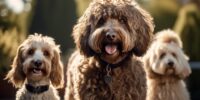Why Mastiffs Are Suited for Experienced Dog Owners
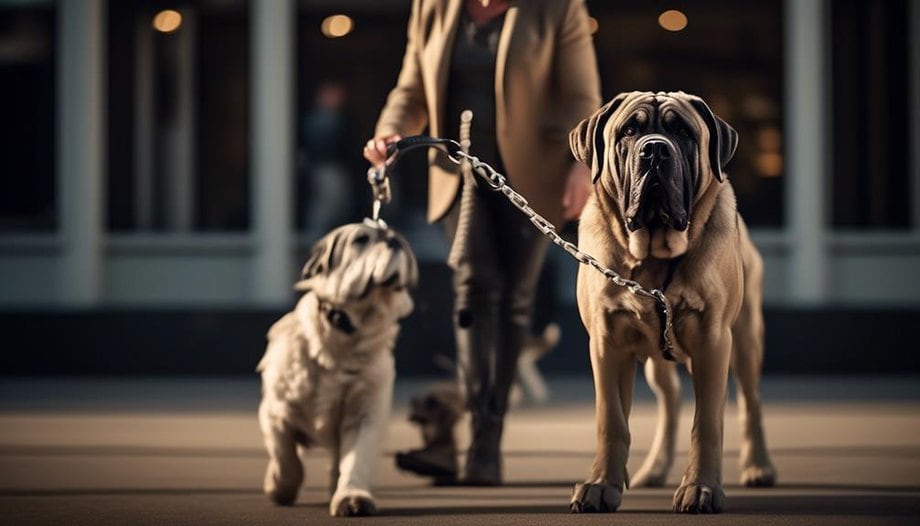
Mastiffs are suited for experienced dog owners due to their massive size. They can weigh over 200 pounds, making them one of the largest dog breeds. This size can be intimidating and challenging to handle for someone who is not experienced with large dogs.
Another reason why Mastiffs are better suited for experienced owners is their potential aggression towards other dogs. While Mastiffs can be gentle and loving with their family, they can also be aggressive towards unfamiliar dogs, especially if they feel threatened or if they are not properly socialized. Dealing with this aggression requires knowledge and experience to handle and manage.
In addition to their size and potential aggression, Mastiffs also have health issues that require specialized care. They are prone to certain conditions, such as hip dysplasia and bloat, which can be costly to treat and require close monitoring. Experienced owners are more likely to have the knowledge and resources to provide the necessary care for these health issues.
To successfully own a Mastiff, confident leadership is essential. These dogs need a strong and assertive owner who can establish themselves as the pack leader. Without this confident leadership, Mastiffs can become stubborn and difficult to handle.
Early socialization is also crucial for Mastiffs. By exposing them to different people, animals, and environments from a young age, they can develop into well-rounded and well-behaved dogs. Experienced owners will have a better understanding of the importance of socialization and how to properly socialize their Mastiffs.
In conclusion, Mastiffs are best suited for experienced dog owners. Their massive size, potential aggression towards other dogs, and health issues require confident leadership, early socialization, and specialized care. Only those with the necessary knowledge and experience can provide the optimal environment and care for these magnificent dogs.
Key Takeaways
- Mastiffs require owners with the necessary strength and control to handle their massive size.
- Mastiffs can exhibit aggression towards unfamiliar dogs if not properly socialized and trained.
- Mastiffs are prone to certain health conditions that require specialized care and regular veterinary monitoring.
- Mastiffs need a confident and assertive owner who can establish themselves as the pack leader.
Mastiff Temperament
Mastiffs exhibit a dignified and docile temperament, making them well-suited for experienced dog owners. Known for their loyalty and protective nature, these dogs can be a great addition to the right household. However, their temperament requires careful consideration and understanding.
Mastiffs are often described as standoffish or suspicious of strangers. This trait stems from their natural guarding instincts, making them excellent watchdogs. However, it also means that early socialization and consistent training are necessary to ensure they become well-rounded and friendly members of society. It's important for owners to expose them to different environments, people, and animals from a young age to prevent any potential behavioral issues.
Training a Mastiff requires patience and positive reinforcement. Harsh training methods aren't recommended, as they can lead to fear or aggression. Basic obedience training is essential for any dog, but Mastiffs may also enjoy advanced training or activities like agility. These exercises can help keep them mentally stimulated and physically fit.
Although Mastiffs aren't commonly used as sporting dogs due to their lack of endurance and prey drive, their calm and gentle nature makes them excellent companions and therapy dogs. They're known for their ability to provide comfort and support to those in need.
Training Requirements
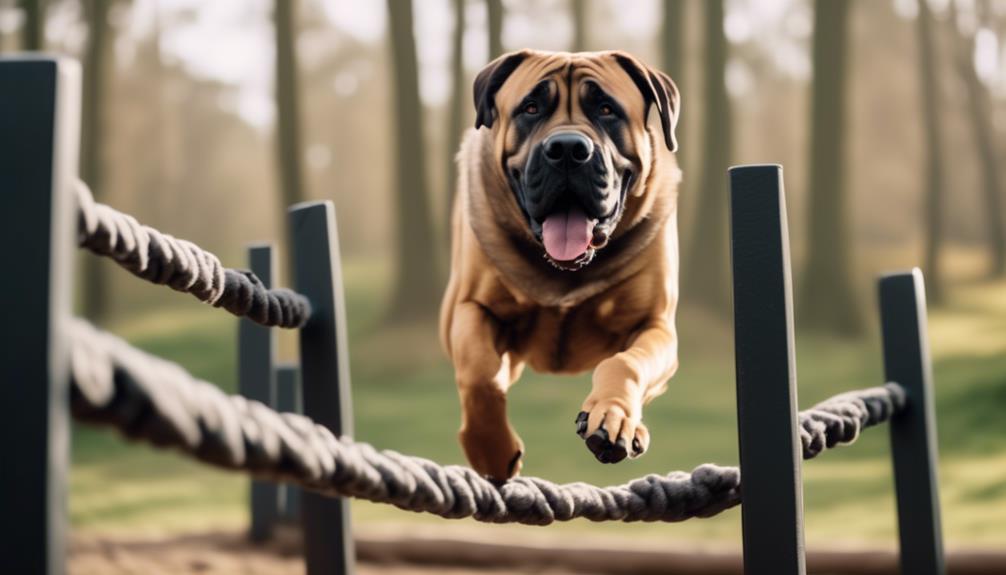
Training requirements for Mastiffs include patience and positive reinforcement due to their occasional stubbornness. Early socialization and consistent training are vital to prevent undesirable behaviors in Mastiffs. Here are three key points to consider when training a Mastiff:
- Establish a calm and assertive presence: Mastiffs are known for their calm demeanor, but they can also be independent and strong-willed. It's important for the owner to establish themselves as a confident and consistent leader. This requires patience and a calm approach to training.
- Provide a fenced yard for exercise: Mastiffs are large dogs that require plenty of physical activity to maintain their health. A securely fenced yard allows them to roam and explore safely. Regular exercise helps prevent behavioral issues that may arise from pent-up energy.
- Focus on obedience training: Mastiffs respond well to basic obedience training. Teaching them commands like sit, stay, and come will help them understand their role within the household. However, training sessions should be kept short to maintain their attention and prevent them from becoming obstinate.
It is important to note that Mastiffs may be prone to certain health problems, so it's crucial to consult with a veterinarian to ensure the training methods used are appropriate for their specific needs. By understanding and meeting the training requirements of Mastiffs, experienced dog owners can develop a strong and well-behaved companion.
Challenges of Owning a Mastiff
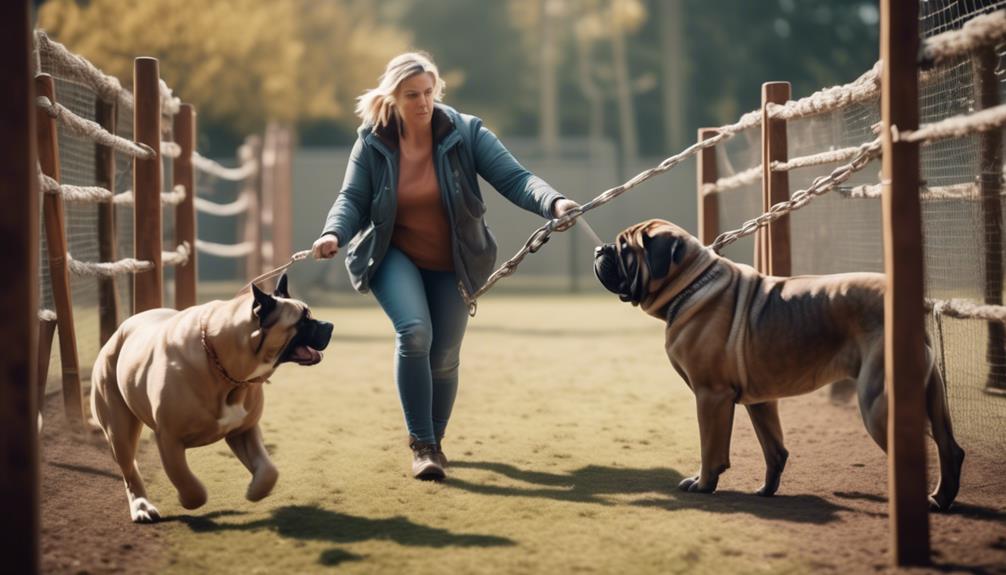
One must be prepared for the various challenges that come with owning a Mastiff, a large breed known for its short lifespan and specific care requirements.
The size of Mastiffs alone presents a challenge for owners, as they require ample space to move around and exercise. Their large size also means that they can unintentionally knock over small children or fragile objects in their path.
Additionally, Mastiffs have a good nature and are generally gentle, but they can exhibit aggression if not properly socialized and trained. This requires experienced dog owners who are patient, consistent, and knowledgeable about positive reinforcement training methods.
Mastiffs are also prone to certain health issues, such as hip dysplasia and bloat, which require regular veterinary care and screening. The cost of caring for a Mastiff can be significant, including expenses for food, grooming, and medical care.
It's crucial to find a reputable breeder who prioritizes the health and well-being of their dogs to avoid potential genetic issues. Overall, the challenges of owning a Mastiff can be overcome with the right knowledge, experience, and dedication from the owner.
Physical Characteristics of Mastiffs
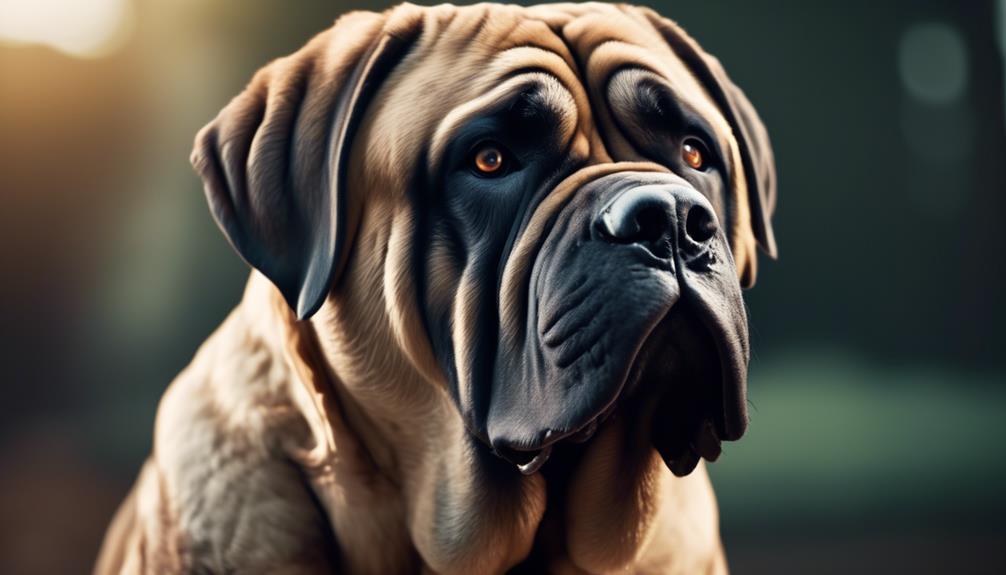
With their massive and dignified appearance, Mastiffs captivate attention with their large, wide-set dark brown eyes and a short, square muzzle with a broad, dark nose. These physical characteristics are what make English Mastiffs stand out among other dog breeds. Here are three key physical characteristics of Mastiffs that are contextually relevant to this article section:
- Impressive Size: English Mastiffs are known for their size, with males standing at 30 inches and above, and females at 27.5 inches and above. This large stature can be intimidating to some, but experienced dog owners understand how to properly handle and care for such a powerful breed.
- Weight: Male Mastiffs typically weigh between 160-230 pounds, while females weigh between 120-170 pounds. Their substantial weight adds to their imposing presence and reinforces the need for experienced dog owners who can provide the necessary strength and control.
- Coat and Facial Features: Mastiffs have a short, coarse topcoat with a dense undercoat. They come in various coat colors, including apricot, brindle, and fawn, often with a dark mask. Additionally, Mastiffs are known for their wrinkled heads, which require regular grooming and attention to prevent infection.
Understanding these physical characteristics is crucial for experienced dog owners considering a Mastiff. Their size, weight, and distinctive facial features require responsible ownership and proper training to ensure their well-being and the safety of others.
Health and Grooming Needs
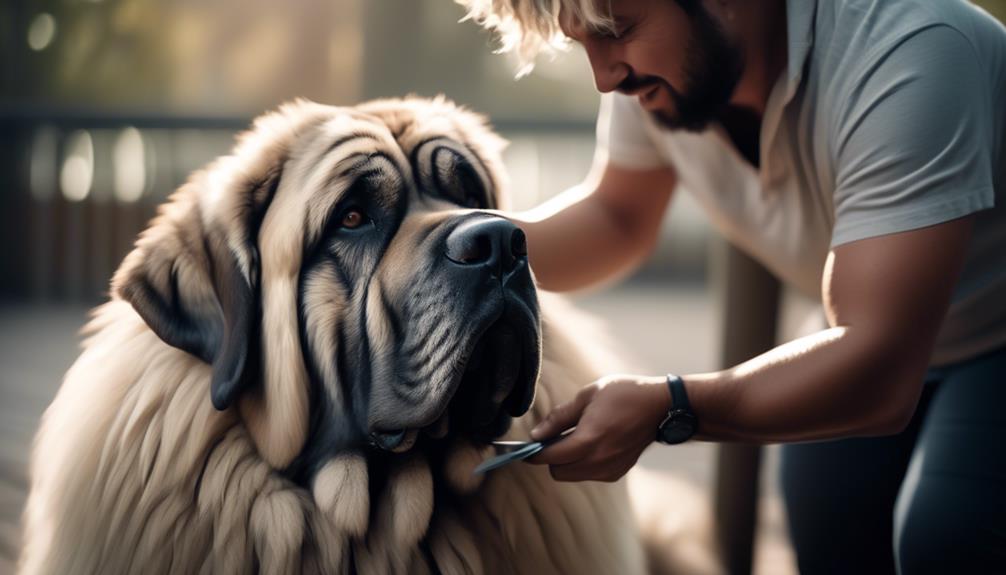
To properly care for Mastiffs, experienced dog owners must prioritize their health and grooming needs. Mastiffs have a life expectancy of 6-10 years, and to ensure they live a healthy and happy life, owners must be diligent in providing them with regular grooming and health care.
Mastiffs have a short coat, but they shed year-round, so daily or weekly brushing is necessary to reduce stray hair and maintain their coat's health. In addition to brushing, regular bathing, wiping of the eyes and face, and nail trimming and ear cleaning are essential grooming needs for Mastiffs.
When it comes to their health, Mastiffs are prone to several common issues. These include hip dysplasia, cancer, gastric torsion, eye diseases, arthritis, seizures, orthopedic concerns, cystinuria, and hypothyroidism. Experienced owners should be aware of these potential health concerns and take appropriate measures to prevent and manage them. Purchasing a Mastiff from a reputable breeder and screening for common diseases can help minimize these health issues.
Experienced dog owners should also consider obtaining insurance for their Mastiffs. Insurance companies offer policies specifically designed for Mastiffs that can help cover the costs of medical treatments and procedures.
Mastiffs' Energy Levels
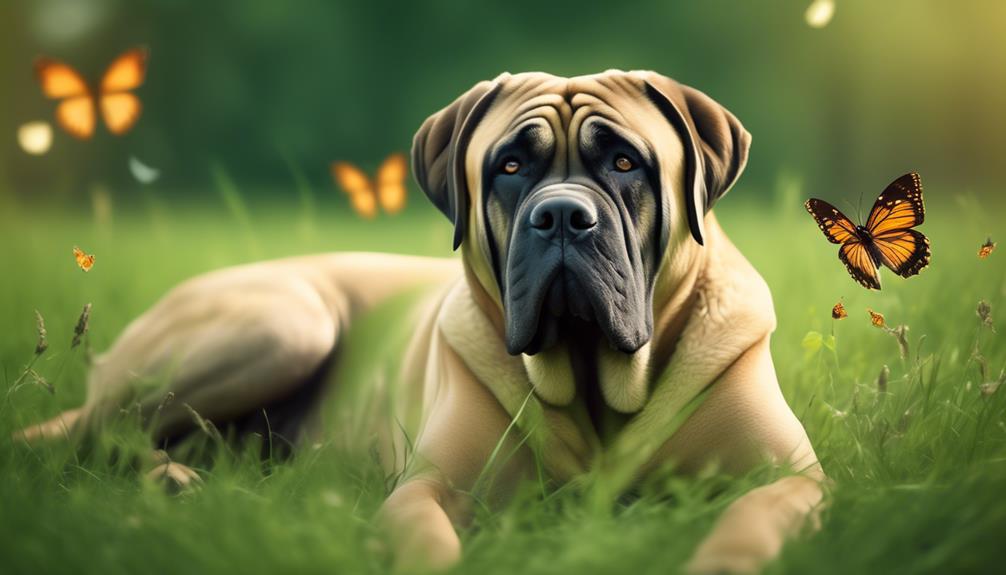
Experienced dog owners should be aware that, in addition to prioritizing the health and grooming needs of Mastiffs, understanding their energy levels is crucial. Mastiffs, being an old and calm breed, have low to moderate energy levels. Here are three key points to consider regarding their energy levels:
- Enough Exercise: While Mastiffs are a giant breed, they don't require as much exercise as one might expect. They typically need around 30-40 minutes of exercise per day to maintain their health and well-being. This can be achieved through leisurely walks or gentle play sessions.
- Calm and Quiet: Mastiffs are known for their calm and gentle nature, making them the ideal companions for those seeking a calm and peaceful environment. They prefer spending time relaxing at home rather than engaging in strenuous physical activities. Their tranquil demeanor makes them perfect for individuals who desire a serene and quiet household.
- Temperature Sensitivity: It's important to note that Mastiffs can overheat easily, especially in hot weather. They're more comfortable in cooler climates and shouldn't be exposed to hot temperatures for extended periods. Providing them with a cool and shaded environment is essential to ensure their well-being.
Understanding these energy levels is crucial for potential Mastiff owners. By providing enough exercise, creating a calm and quiet living environment, and being mindful of temperature sensitivity, Mastiffs can thrive and bring joy to their owners' lives.
Finding the Right Mastiff for You
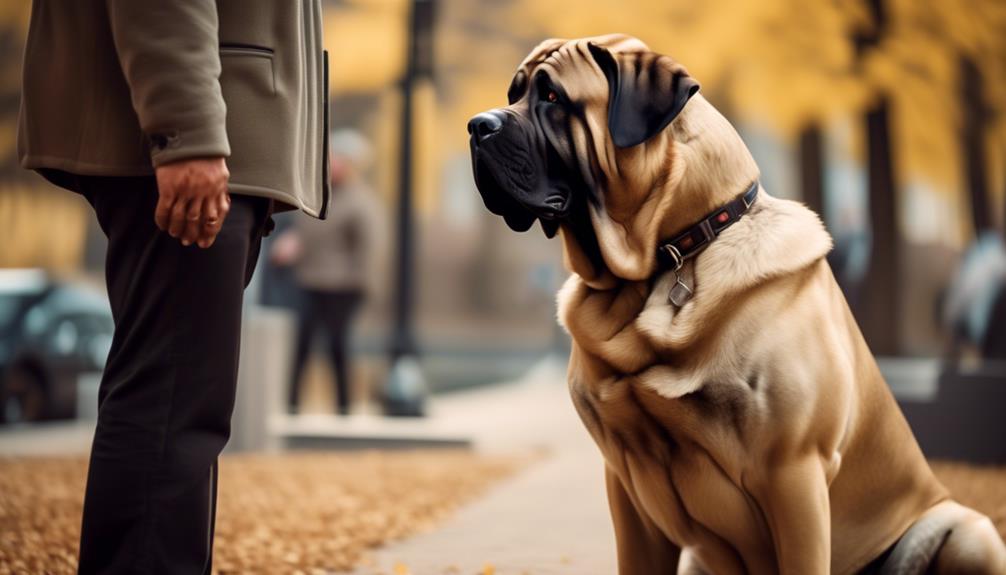
Finding the ideal Mastiff to suit your lifestyle requires careful consideration of various factors, including temperament, size, and exercise needs. For experienced dog owners, it's important to choose a Mastiff that matches their level of expertise and commitment. Mastiffs are known for their massive size and dignified nature, making them suitable for owners who can handle their strength and assertiveness.
It's essential to assess the temperament of a Mastiff before bringing one into your home. While they're generally loyal and devoted, early socialization and consistent training are crucial to prevent undesirable behaviors.
Size is another important consideration when selecting a Mastiff. These dogs are heavy-boned and require ample space to move around comfortably. Therefore, it's essential to have a home with enough room to accommodate their size. Additionally, Mastiffs aren't meant to live outdoors full time and thrive in moderate climates. They require moderate exercise, such as daily walks, to keep them physically and mentally stimulated.
Lastly, grooming needs should be taken into account. Mastiffs have a short coat that requires regular brushing to keep it clean and healthy. They also need regular bathing, nail trimming, and ear cleaning to maintain their overall well-being.
Frequently Asked Questions
What Are the Advantages of a Mastiff?
The advantages of owning a Mastiff include their calm and affectionate temperament, their large size which can provide a sense of security, their moderate exercise needs, their grooming requirements, and their health concerns that should be monitored. Training tips can help ensure a well-behaved companion.
Who Should Own a Mastiff?
Mastiffs require experienced dog owners who understand their temperament, exercise needs, and training requirements. They are generally good with other pets and older children, but caution is advised around babies and toddlers. Mastiffs are not well-suited for apartment living.
How Hard Is It to Own a Mastiff?
Owning a mastiff can be challenging due to their training needs, exercise requirements, grooming needs, health concerns, socialization difficulties, and potential for aggression. Experienced dog owners are better equipped to handle these challenges.
Are Mastiffs Protective of Their Owners?
Mastiffs are highly protective of their owners due to their natural instincts. Their loyalty and devotion make them well-suited as family pets. However, training challenges and the need for early socialization require experienced dog owners.


